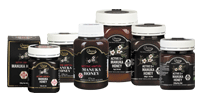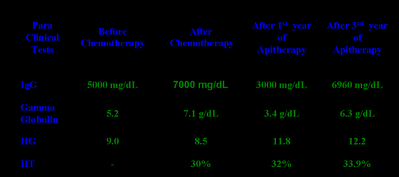 APIMEDICA 2006, October 12-15, 2006, Athens, Greece
APIMEDICA 2006, October 12-15, 2006, Athens, Greece
Presenter: Bioch. Cristina Mateescu, Ph.D. Sen.Res.II, Institute for Apicultural Research and Development, Bucharest, Romania; Apimondia Standing Commission of Apitherapy
E-Mail: crismatapiter@hotmail.com or
apicult@sunu.rnc.roExtraction Methods:1. The selection of the solvent depends on the final use of the extract and on technical feasibilities.
2. Most active ingredients seem to be soluble in propylene glycol and ethanol.
3. Fewer ingredients are soluble in water, but even water extracts show at least some bactericidal and fungicidal effects, as well as wound healing properties.
4. Acetone extracts have been used for production of shampoos and lotions.
5. Once the specific chemicals or chemical groups and their biological effects are better understood, better and more specific extracts can be prepared for equally specific applications.
Method 1: Ethanol Extracted Propolis (EEP) - the simplest method for extracting propolis
Method 2: Quick extraction
Method 3: Glycol (ethylene glycol) extracted propolis (GEP)
Method 4: Aqueous (water) extracted propolis (AEP)
Method 5: Oil extracted propolis (OEP)
Method 6: Propolis paste
Method 7: Dry propolis extract
Method 8: Water-soluble, dried powder ethanol extracts
Method 9: Free-flowing, non-hygroscopic propolis powder
Method 10: Water soluble derivatives (WSD)
Method 11: supercritical fluid extraction
Propolis Preparations:Tinctures
Officinal tincture 25% in 70% ethanol
30% propolis tincture in 96?ethanol
Extraction period – 21 days in dark bottles, occasional stirrings
Filtration
Dilutions to 5, 10% (sprays, lighter tinctures, syrups etc.)
Soft propolis extracts
Concentration of the mother tinctures (roto-evaporators)
It can be used itself or in various formulations (creams, ointments, lotions, tablets, and capsules.
Pollen Extracts:1. To avoid the granular structure of pollen or avoid some of the allergenic effects, pollen extracts can be prepared.
2. The most common solvents for extraction are various types of alcohols. The higher the alcohol concentration, the more complete is the extraction of oils, fats, colours, resins and fat soluble vitamins from pollen.
3. Solvents with lower concentration of alcohol mainly dissolve tannins, acids and carbohydrates.
4. Therefore, with a variation of the alcohol concentration different types of extracts can be prepared.
5. A propylene glycol extract contains most water soluble material, leaving behind the proteins, thus eliminating most, if not all allergenic material.
6. Such an extract is well suited for external applications such as in cosmetics.
7. Oil extractions have been reported as inefficient.
8. Treatment with di-ethylene glycol mono-methyl ether discolors pollen and its extracts (D'Albert, 1956) where coloration may not be desired (cosmetics).
9. An extract can be prepared with a very high percent alcohol (95 % or more) to get most of the substances out of the pollen.
10. The alcohol has to be food grade (fit for human consumption).
11. Distilled beverages usually contain 40-60% alcohol or less, and so only produce less complete extracts.
12. A dark glass bottle is filled with 4 parts of 95% alcohol and 1 part of beebread (pollen)
13. Beebread has a higher nutritional value.
14. The mixture is stirred at least once a day and left 8 days for extraction.
15. More frequent agitation improves extraction.
16. The mixture is filtered through a fine cotton cloth and stored in a dark glass bottle.
17. It can be stored for a long time.
18. The filtrate can again be washed in water and this weaker extract may be used immediately.
Royal Jelly Preparations:Fresh royal jelly
Fresh royal jelly in honey
Lyophilized royal jelly (freeze dried royal jelly).
In capsules, tablets, lotions, syrups, etc.
Aro-Honey for Internal Usage:1. Total concentration 3-5% essential oils;
2. 100 drops of essential oil for 100 g honey
3. If more essential oils are used, the 100 drops are divided accordingly. Thus for:
2 essential oils – 50 drops of each
3 essential oils – 33 drops of each
4 essential oils – 25 drops of each
Aro-Honeys for External Application:1. 25 drops of essential oil for each 100 g of honey
2. Final concentration – no more than 1%
3. Homogenization for at least 5 minutes, with a plastic or a wooden spoon (metallic spoons should be avoided).
 Effect of Honey Bee Venom on Microglial Cells Nitric Oxide and Tumor Necrosis Factor-Alpha Production Stimulated by LPS
Effect of Honey Bee Venom on Microglial Cells Nitric Oxide and Tumor Necrosis Factor-Alpha Production Stimulated by LPS


 Apoptosis of Human Melanoma Cells Induced by the Novel Compounds Propolin A and Propolin B from Taiwenese Propolis
Apoptosis of Human Melanoma Cells Induced by the Novel Compounds Propolin A and Propolin B from Taiwenese Propolis By
By 





 Findings in Cardiology Reported from Lithuania and France
Findings in Cardiology Reported from Lithuania and France



 By Zoe Fraley,
By Zoe Fraley, 











 Bee Sting 'Cures Pain'
Bee Sting 'Cures Pain'
 APIMEDICA 2006, October 12-15, 2006, Athens, Greece
APIMEDICA 2006, October 12-15, 2006, Athens, Greece








 Wound Healing With Honey--A Randomised Controlled Trial
Wound Healing With Honey--A Randomised Controlled Trial

